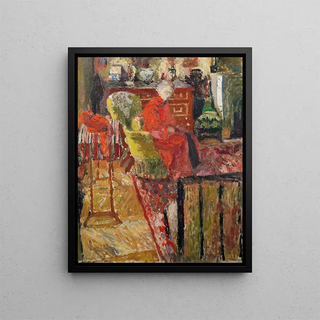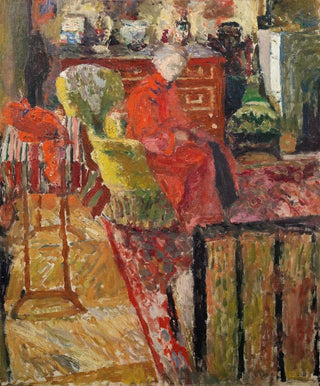Art print | Madame Vuillard in a red robe - Édouard Vuillard


View from behind

Frame (optional)
In the fascinating world of art, some works transcend their era to become timeless witnesses to the human soul. "Madame Vuillard in a red robe" by Édouard Vuillard is one of these creations, capturing the intimacy of a fleeting moment while revealing the psychological depth of its subject. This emblematic piece, depicting the artist's wife in a domestic setting, evokes not only the beauty of everyday life but also offers a reflection on the individual's place within their environment. The delicacy of the colors and the richness of the textures make this artwork a true visual jewel, inviting the viewer to delve into the intimacy of its universe.
Style and uniqueness of the work
Vuillard's style is often described as post-impressionist, but it goes far beyond this label. In "Madame Vuillard in a red robe," the artist employs bold color strokes and delicate patterns to create a warm and enveloping atmosphere. The woman, draped in her red robe, appears both vulnerable and strong, embodying a duality at the heart of the piece. The play of light and shadow, along with the floral motifs decorating the background, adds an almost dreamlike dimension to the scene, transforming a simple moment of life into a profound aesthetic experience. This painting is an ode to femininity, to the beauty of everyday life, and to the capacity of art to capture the ephemeral.
The artist and his influence
Édouard Vuillard, a member of the Nabi movement, established himself as a major figure in French painting at the end of the 19th century and the beginning of the 20th century. His innovative approach, blending intimacy and modernity, influenced many artists, both contemporaries and those who followed. By focusing on themes of domestic life and human relationships, Vuillard paved the way for a new way of viewing art, where the everyday becomes a source of inspiration. His use of colors and motifs also prefigured certain currents of the 20th century, notably Fauvism and abstract art. Through his works

Matte finish

View from behind

Frame (optional)
In the fascinating world of art, some works transcend their era to become timeless witnesses to the human soul. "Madame Vuillard in a red robe" by Édouard Vuillard is one of these creations, capturing the intimacy of a fleeting moment while revealing the psychological depth of its subject. This emblematic piece, depicting the artist's wife in a domestic setting, evokes not only the beauty of everyday life but also offers a reflection on the individual's place within their environment. The delicacy of the colors and the richness of the textures make this artwork a true visual jewel, inviting the viewer to delve into the intimacy of its universe.
Style and uniqueness of the work
Vuillard's style is often described as post-impressionist, but it goes far beyond this label. In "Madame Vuillard in a red robe," the artist employs bold color strokes and delicate patterns to create a warm and enveloping atmosphere. The woman, draped in her red robe, appears both vulnerable and strong, embodying a duality at the heart of the piece. The play of light and shadow, along with the floral motifs decorating the background, adds an almost dreamlike dimension to the scene, transforming a simple moment of life into a profound aesthetic experience. This painting is an ode to femininity, to the beauty of everyday life, and to the capacity of art to capture the ephemeral.
The artist and his influence
Édouard Vuillard, a member of the Nabi movement, established himself as a major figure in French painting at the end of the 19th century and the beginning of the 20th century. His innovative approach, blending intimacy and modernity, influenced many artists, both contemporaries and those who followed. By focusing on themes of domestic life and human relationships, Vuillard paved the way for a new way of viewing art, where the everyday becomes a source of inspiration. His use of colors and motifs also prefigured certain currents of the 20th century, notably Fauvism and abstract art. Through his works






